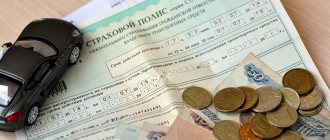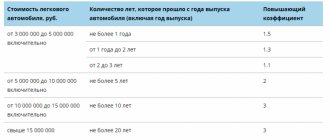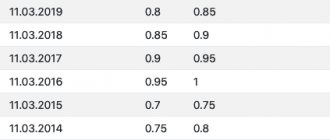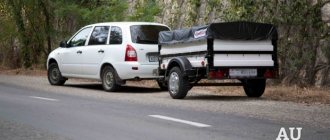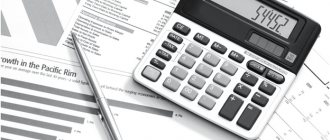Bonus-malus coefficient and its impact on the cost of compulsory motor liability insurance
Civil liability insurance for motorists operates according to a system that takes into account the interests of each party - the driver and the insurance company. To reduce their risks, the latter determine how much the compulsory motor liability insurance will increase after an accident using the client’s careful driving. Based on these indicators, special values are determined. They can affect the cost of compulsory motor liability insurance in any direction - downward or upward.
The most important indicator characterizing accident-free driving is bonus malus. The more professionally and carefully the driver drives the vehicle, the lower it is.
If the driver did not have an accident in the previous insurance period, he will be given a 5 percent discount. It is cumulative and can reach 50%. If the motorist provoked an accident, then the multiplier will increase and, as a result, compulsory motor liability insurance will become more expensive after the accident.
Thanks to KBM the following is achieved:
- Incentives are created for drivers to drive accident-free;
- The level of accuracy of all road users increases;
- Reducing the number of claims for compensation for minor damage.
What affects the cost
The cost of services in this area is regulated by the Central Bank of Russia. It provides maximum and minimum prices for services. Insurance companies can change the cost within this interval, but do not have the right to go beyond the approved limits.
The price consists of the following factors:
- Type of vehicle;
- Legal status of the client;
- For what purpose will the car be used?
There are also additional parameters that can greatly affect the final cost of the policy:
- Technical condition of the car;
- Age and driving experience;
- The number of persons included in the insurance policy and having the right to drive a vehicle;
- Accident-free driving experience.
Let's take a closer look at the main parameters that influence the final cost.
Number of drivers included in insurance
When applying for a policy, you can specify additional persons who can drive the vehicle.
You can add an additional person to your insurance at any time. The main thing is that this is done within the validity period of the insurance.
If the additional driver has a sufficiently long history of accident-free driving and is not a persistent violator of traffic rules, then in this case the coefficient that will be used in calculating the final cost will be equal to 1, i.e. Registration will be free of charge.
When applying for an insurance policy without restrictions, most insurance organizations use a coefficient of 1.8.
The amount of horsepower in a car
The greatest influence on the price of insurance is the amount of horsepower that the car's engine develops. The more horsepower a car has, the higher the likelihood of being involved in a traffic accident. There is a gradation of horsepower, on the basis of which the insurance price is based.
The minimum coefficient of 0.6 is used for power less than 50 hp. The maximum is 1.6 and applies if the car’s power exceeds 150 hp . There are also intermediate values.
Number of accidents
The main coefficient is KBM, which depends on driving accuracy. It is he who determines how much insurance will rise after an accident. .
Its value varies from 0.5 to 2.4 and after the driver gets into an accident, it immediately changes upward.
For each year of accident-free driving, the insurance company makes a 5% discount on the next policy. Thus, the insurance company encourages people to be careful on the road.
How will the cost of compulsory motor liability insurance change for the person at fault in an accident?
The driver can independently determine how much the compulsory motor liability insurance increases after an accident, and how much it will decrease during accident-free driving. This procedure is quite simple. For calculations, insurance organizations use certain values of the increasing BMR. Its value can be found in the table:
| KBM last year | KBM in 2021 (taking into account the number of insurance payments received) | ||||
| 0 payouts | 1 payment | 2 payments | 3 payments | 4 or more payments | |
| 0,5 | 0,5 | 0,8 | 1 | 1,55 | 2,45 |
| 0,55 | 0,5 | 0,85 | 1 | 1,55 | 2,45 |
| 0,6 | 0,55 | 0,85 | 1 | 1,55 | 2,45 |
| 0,65 | 0,6 | 0,85 | 1 | 1,55 | 2,45 |
| 0,7 | 0,65 | 0,9 | 1,4 | 1,55 | 2,45 |
| 0,75 | 0,7 | 0,9 | 1,4 | 2,45 | 2,45 |
| 0,8 | 0,75 | 0,95 | 1,4 | 2,45 | 2,45 |
| 0,85 | 0,8 | 0,95 | 1,4 | 2,45 | 2,45 |
| 0,9 | 0,85 | 1 | 1,55 | 2,45 | 2,45 |
| 0,95 | 0,9 | 1,4 | 1,55 | 2,45 | 2,45 |
| 1 | 0,95 | 1,55 | 2,45 | 2,45 | 2,45 |
| 1,4 | 1 | 1,55 | 2,45 | 2,45 | 2,45 |
| 1,55 | 1,4 | 2,45 | 2,45 | 2,45 | 2,45 |
| 2,3 | 1,55 | 2,45 | 2,45 | 2,45 | 2,45 |
| 2,45 | 2,3 | 2,45 | 2,45 | 2,45 | 2,45 |
Previously, driver classes were used, there were 15 of them in total: M, 0, 1..13. Now a simple coefficient is used, which can be easily found from the table. This is the first time such a change has been made in many years. Now it is in the range from 0.5 to 2.45.
According to the new rules, the KBM for compulsory motor liability insurance after an accident changes once a year - on April 1. Thanks to this change, it is easier to check the current coefficient and update it. Whenever an insurance agreement is signed, payments for the previous year are taken into account. The RSA database contains information about the bonus-malus coefficients for each motorist. The insurance company can receive this information and use it to calculate the cost of compulsory motor liability insurance.
When you first issue a motor vehicle license, you will be assigned KBM 1. After an accident, the MTPL increasing coefficient will increase to 1.55 in the event of one accident. For two or more incidents, the multiplier will increase to 2.45. Such a sharp increase only applies to drivers with a single multiplier.
In general, the trend is that the coefficient gradually decreases for accident-free driving. However, after an accident, the cost of compulsory motor liability insurance simply soars. Then it gradually decreases again in the absence of calls to the insurance company.
How does it increase after an accident?
How to check KBM according to OSAGO?
How to restore KBM in the RSA database?
How to reduce the cost of OSAGO?
The CBM is applied after all other coefficients have been applied. Each insurance organization compiles a table from which you can determine how much your insurance will increase after a traffic accident.
Let's consider a situation when a potential client contacts an insurance company for the first time.
In this case, he is awarded class 3, which corresponds to a BMR of 1. If during the insurance period the client gets into an accident, then the next year he will be awarded class 1 and the BMR will be 1.55. Thus, in case of one accident, the price of the next policy will be 55% higher.
The more accident-free driving experience, the lower the price of concluding an insurance contract.
Consider a situation where the client has 10 years of accident-free experience. In this case, the BMR will be 0.65. If this client has an accident, then the next year the BMR will be 0.85. Thus, the final insurance price will increase by 20%.
Consequently, the more experience of accident-free driving, the less the cost of insurance in case of an accident will increase.
If the driver gets into more than 1 accident, then the next time the contract is concluded, you will have to pay much more.
How long does the increased MTPL coefficient last after an accident?
After an increase in the multiplier as a result of an accident, a motorist is usually interested in how long the increasing coefficient of compulsory motor liability insurance lasts after an accident. The value of the indicator is reviewed annually, in parallel with the purchase of the next insurance policy. The bonus-malus coefficient is not used in the following situations:
- a motor vehicle permit is issued for transit vehicles;
- the car has been registered in another state, but is temporarily registered in the Russian Federation;
- the trailer is insured;
- The insurance contract is issued for a period of less than 12 months.
When does the insurance company have the right to refuse?
A number of cases when payments on obligations are not made:
- If the contract specifies a limited number of people, and the driver was not insured at the time of the accident.
- We are dealing with the destruction of nature.
- As a result of the accident, property or health damage was caused not by the car, but by uninsured cargo.
- The injured party demands compensation for lost profits.
- The amount of compensation is higher than the maximum amount established in the insurance contract.
- The damage was caused during educational, sports or experimental activities, during loading and unloading operations or on the territory of the organization.
Is it possible to avoid assigning an increasing coefficient under compulsory motor liability insurance in case of an accident?
It may seem that the owner of a car cannot avoid negative consequences if he gets into a traffic situation. This does not happen in every case. Not all traffic incidents result in an increase in the bonus-malus ratio.
One of the situations is when a driver is a victim of the actions of another driver. In such a situation, he will receive an insurance payment, and his BMI will not change. You can also avoid increasing the rate if you exclude the at-fault driver from the list of persons who have the right to drive a car for the next year. In such a situation, the insurance company will determine the need to use increasing coefficients taking into account the insurance history of those who remain on the list of trusted motorists.
In the past, car owners tried to avoid liability by changing their insurance company. They hid their participation in the accident when signing the agreement. Now such attempts do not allow success, since all information flows into a single RSA database, from which all insurers can obtain information. At the moment, the only legal method to reduce insurance costs is careful and careful behavior on the road.
Is it possible to avoid price increases?
However, other parameters also affect the cost of insurance. These indicators are determined by specific life circumstances and technical characteristics. For this reason, motorists have the right to independently change only the KBM - in the event of an accident, the constant will increase, and careful behavior on the road reduces the cost of insurance.
If we talk about other coefficients that affect the price of the policy, here are the following values:
- Violation of agreements. In case of periodic deviation from the conditions specified in the agreement, a CN constant of 1.5 is applied to the driver. Compliance with the agreement with insurers sets this parameter to the value “1”.
- The relationship between driving experience and client age. The KBC coefficient varies between 1–1.8. The minimum value corresponds to drivers who, by the age of 22, have achieved at least three years of driving experience, and the maximum value is determined by the inverse value.
- Issue of a policy for an unlimited number of motorists. In this case, the KO value is 1.8.
- Vehicle power characteristics. For low-power vehicles with performance up to 50 hp. With. a KM constant of 0.6 is applied. If the car’s parameters exceed the 150 hp mark. s., the maximum value of KM is used, which is 1.6.
- Transport registration location. Motorists who live in regions with low accident rates are charged a minimum CT coefficient of 0.6. For residents of megacities, the value of this parameter increases to a maximum value of 2.1.
Since long-term cooperation with a certain insurance company implies that the client receives some privileges, let’s return to the consideration of the KBM and find out whether it will be possible to reduce this value.
The law provides for a number of circumstances under which the price of compulsory motor liability insurance does not increase. First of all, these are all cases in which the other party is found guilty. Then an insured event occurs, in which compensation for expenses is provided by the insurance company of the guilty party, and the value of the CBM for the injured party does not change due to this incident. This is fair, there should be personal responsibility.
You should know that the ability to avoid increasing the coefficient when changing insurance companies is becoming a thing of the past. An improved database of all drivers will not provide this opportunity. For this reason, your control over the correct execution of documents will not be superfluous. Insurance companies may not always keep accurate records of data; there may also be unscrupulous companies that deliberately will not use the system of discounts for accident-free operation.
The MTPL law regulates the cost of a compulsory motor vehicle insurance policy and is calculated by all insurance companies using a single formula: the base rate established by the state is multiplied alternately by the coefficients provided by law.
Thus, the coefficient can:
- increase if the coefficient value is greater than 1;
- decrease if value is less than 1;
- do not change if the value is 1.
One of these coefficients provided by law is the “bonus-malus” coefficient, which characterizes the discipline of the vehicle owner.
For example, for passenger cars that belong to individuals, the base tariff corridor is set within the range of 3,432 - 4,118 rubles. It is the size of the base rate that the insurance company chooses that determines how much a compulsory motor third party liability policy costs.
Don’t want to think about how much your insurance will increase after an accident? This is quite possible, since the KBM directly depends on the principles of your driving. Follow all the rules of conduct on the roads without exception, and you will minimize the risk of becoming the initiator of a traffic accident.
As for other absolutely legal and effective methods to avoid increasing the cost of a car license, they simply do not exist.
Solving the problem of increasing the overall level of road safety, the state gave insurance companies the right to use a special coefficient when determining the cost of car insurance, which can adjust the price of the policy up or down. This coefficient, which has become mandatory for calculations, is called bonus malus (KBM) for the opportunity to reward the driver with a pleasant bonus or downgrade his class depending on the quality of driving during the previous year.
If a motorist does not allow any accidents during the year that require the insurer to compensate the injured party, then as an incentive he will increase his driving skill class. As a result, next year the MTPL policy for him will cost less, since the bonus part of the coefficient will be applied when calculating the cost of insurance. A disciplined driver will receive a discount and an incentive to continue driving carefully.
But what happens if a car owner is involved in at least one traffic accident during the insurance year? In this case, having incurred the costs of compensating the damage to the party injured in the accident, the insurer will punish its client for unreliability and violation of driving rules. The malus principle will be applied to the reckless driver, reducing the driver's class. As a result, the cost of the policy will increase significantly.
Insurers are especially sensitive to inexperienced drivers who have recently gotten behind the wheel of a car. The lack of information for previous periods does not allow us to evaluate the ride quality of such a newcomer. In such a case, the insurance company, protecting its own risks, assigns it the 3rd class of skill. And only further driving practice will show whether a new car enthusiast will be able to increase it, earning pleasant discounts, or will get into an accident and pay much more for the next policy.
Until 2013, the results of accidental driving for previous years could be reset to zero, and any driver could get 3rd class. To do this, he only had to stop cooperation with the previous insurer and enter into an agreement with a new insurance company. However, at present, careless motorists are deprived of such an opportunity.
Fearing that insurers will increase the value of CBM for mistakes made on the road, many drivers are wondering if there is a way to avoid increasing the cost of compulsory motor liability insurance. It turns out that there is such a possibility. If several drivers are allowed to drive a car, and one of them provoked the occurrence of an insured event, the value of the BMR will not change if, when purchasing a new policy, the person responsible for the accident is excluded from the list of persons entrusted with driving the car.
But the best way not to worry about the changed values of the bonus-malus is careful and attentive driving. You should not look for workarounds to reduce the cost of purchasing compulsory motor insurance. Preference should be given to traffic safety on the road, which comes before savings and costs a person much more.
How to restore the KMB coefficient for compulsory motor liability insurance after an accident
If a road accident occurs, you can not only lose your existing bonuses, but also lose your KMB multiplier. As already noted, if the driver is not to blame for the incident, he is not in danger.
If you get into an accident due to inattentive driving, violating traffic rules, or being under the influence of drugs or alcohol, the KMB coefficient will be lost. Taking out the next policy will cost much more.
To restore the multiplier, you must drive the car for a long time without an accident. This can be done by contacting the insurer, the Central Bank of the Russian Federation or the Union of Auto Insurers. Some brokers also help restore the bonus-malus ratio.
Reducing the cost of compulsory motor liability insurance
The abbreviation of the term in question hides the chance of a reduction in insurance.
The concept of “bonus” implies that the car owner receives certain privileges, which reduces the price of the policy.
The only option to “increase” the category and reduce the coefficient here is to drive carefully in compliance with traffic rules.
Disciplined drivers who have not used guaranteed payments during the expired contract period receive a discount of 5% of the cost of the original policy.
Since the law requires an insurance period of one year, the absence of accidents during this period gradually reduces the BMI and brings the motorist into the privileged 13th class.
In such situations, the company refers to corruption of information in the database or lack of information about the client. Here, lawyers recommend visiting the RSA portal to restore your insurance history and contacting the guarantor company again.
In addition, it is appropriate to collect certificates from previous agents in order to present these papers upon request.
Since the information in the PCA is “tied” to the number and series of the driver’s license, changing this document eliminates the chance of restoring justice.
In other cases, insurers are forced to correct incorrect information. To reduce the likelihood of getting into an accident, it is advisable to issue a policy for one client and not allow other persons to drive the car.
How to find out the KMB coefficient for OSAGO yourself
If the driver does not want to independently calculate the bonus-malus indicator, you can simply send a corresponding request to the Union of Auto Insurers. All insured motorists have access to the database. A person can independently find the information used by an insurer’s specialist when determining the price of a car insurance policy.
To search for the KBM coefficient using the RSA database, you must perform the following steps:
- Visit the official page of the Union of Auto Insurers;
- Indicate last name, first name and patronymic, information about date of birth and VU number;
- Confirm receipt of coefficient data.
The service will independently produce all the information and provide the visitor with data on the KBM coefficient assigned at the moment.
What to do if you mistakenly increased your compulsory motor liability insurance ratio?
If a citizen moves to another insurance company, the CBM must remain at the same level. However, the insurer can take advantage of the driver’s inexperience and assign him a starting third category. The main argument is the lack of information about the citizen in the RSA database. If a person knows that he is entitled to a discount, the following actions are acceptable:
- personal request for information in the RSA database;
- visit to the previous insurer and obtain a certificate of cooperation;
- obtaining information from the Union of Insurers.
How insurers can deceive clients when calculating compulsory motor liability insurance
Not only motorists strive to return the bonus-malus coefficient to its original value. Insurers also do not want to lose income and provide a discount; they are trying to find different reasons to increase the bonus-malus ratio.
The most common arguments they use to justify their actions are:
- Lack of data on changes in the driver’s documents;
- Failure of fixing equipment or system failure;
- Lack of insurance for the car owner for a year.
In an effort to reset the KBM coefficient, the insurer will explain the incident as a failure in the system. The motorist has the opportunity to return earned bonuses.
How to restore the KBM coefficient when it is reset to zero
The driver should start by collecting certificates from previous insurers. Documents must confirm that the motorist has not been involved in an accident in previous periods. If the owner of the vehicle is unable to confirm the facts with documents, it will not be possible to restore the value of the coefficient.
The MTPL increasing coefficient has a strong impact on the cost of insurance services. There are now strong incentives for careful and accident-free driving. Try to avoid accidents, and you will be able to apply for compulsory motor liability insurance at a big discount.
The ratio of accident rates to a constant
Let's begin to clarify the question of what effect emergency driving has on the growth of this parameter. Since the MTPL insurance policy is designed to pay compensation to third parties, consultants of companies that guarantee compensation for damage take into account the degree of culpability of the client in the accident.
In other words, damage to cars due to the fault of another driver does not become a reason for the motorist involved in an accident to move into the “worst” category. Accordingly, the growth of the parameter in such circumstances is excluded. The degree of guilt of both motorists is checked by a special commission that goes to the scene of the incident.
Since the described value changes only if the fault of the company’s client is proven, let’s find out how much more expensive insurance is after an accident and what calculation system is used by insurance service employees. These questions will help citizens check whether the cost of a civil insurance policy is calculated correctly.


